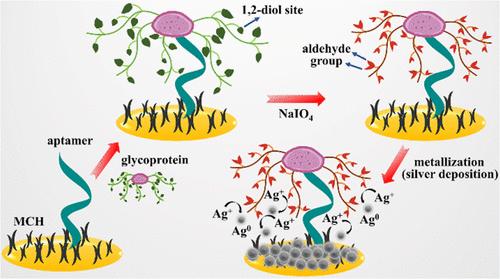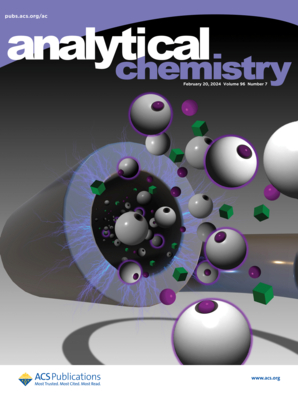用于低浓度糖蛋白免放大电化学检测的糖诱导金属化技术
IF 6.7
1区 化学
Q1 CHEMISTRY, ANALYTICAL
引用次数: 0
摘要
糖蛋白已成为体外诊断中最常筛查的肿瘤标记物。虽然已经提出了大量电化学方法来灵敏检测糖蛋白,但大多数方法都需要借助费力的信号放大。在此,我们报告了利用聚糖迁移金属化(GlyMetal)在低浓度水平下对糖蛋白进行免放大电化学检测的方法。简而言之,相关的糖蛋白会被一个适配体识别层捕获,然后目标物的聚糖会被 NaIO4 氧化,将 1,2 二醇位点转化为醛基,从而实现基于银沉积的金属化,随后沉积的金属银会被电化学剥离,通过已建立的固态银/氯化银伏安过程进行糖蛋白定量。由于 GlyMetal 可以沉积大量的金属银,并且在固态银/氯化银伏安法剥离检测中可以获得较高的信噪比,因此所开发的基于 GlyMetal 的电化学方法适用于糖蛋白的无放大检测。作为概念验证,癌胚抗原(CEA)检测的检测限达到了 1.65 pg/mL。除了高选择性外,该方法在检测血清样本中的癌胚抗原方面也取得了理想的结果。基于 GlyMetal 的电化学方法具有理想的简便性、较短的检测时间以及无扩增方法的成本效益,因此在糖蛋白的床旁检测中大有可为。本文章由计算机程序翻译,如有差异,请以英文原文为准。

Glycan-Evocated Metallization for Amplification-Free Electrochemical Detection of Glycoproteins at Low Concentration Levels
Glycoproteins have become the most often screened tumor markers in the in vitro diagnostics. Although a large number of electrochemical methods have been proposed to sensitively detect glycoproteins, most of them involve the aid of laborious signal amplification. Herein, we report the use of glycan-evocated metallization (GlyMetal) for the amplification-free electrochemical detection of glycoproteins at low concentration levels. Briefly, the glycoproteins of interest are captured by an aptamer recognition layer, and then the glycans of targets are oxidized by NaIO4 to convert the 1,2-diol sites into aldehyde groups for the silver deposition-based metallization, followed by the electrochemical stripping assay of the deposited metallic silver for glycoprotein quantification via the established solid-state Ag/AgCl voltammetric process. As GlyMetal can enable the deposition of a large amount of metallic silver and a high signal-to-background ratio can be obtained for the solid-state Ag/AgCl voltammetric stripping assay, the developed GlyMetal-based electrochemical method is applicable to the amplification-free detection of glycoproteins. As a proof of concept, a detection limit of 1.65 pg/mL has been achieved for carcinoembryonic antigen (CEA) detection. In addition to the high selectivity, desirable results have been obtained with respect to the use of the method for CEA detection in serum samples. In consideration of the desirable simplicity, short assay time, and cost-effectiveness of the amplification-free approach, the GlyMetal-based electrochemical method shows great promise in the point-of-care detection of glycoproteins.
求助全文
通过发布文献求助,成功后即可免费获取论文全文。
去求助
来源期刊

Analytical Chemistry
化学-分析化学
CiteScore
12.10
自引率
12.20%
发文量
1949
审稿时长
1.4 months
期刊介绍:
Analytical Chemistry, a peer-reviewed research journal, focuses on disseminating new and original knowledge across all branches of analytical chemistry. Fundamental articles may explore general principles of chemical measurement science and need not directly address existing or potential analytical methodology. They can be entirely theoretical or report experimental results. Contributions may cover various phases of analytical operations, including sampling, bioanalysis, electrochemistry, mass spectrometry, microscale and nanoscale systems, environmental analysis, separations, spectroscopy, chemical reactions and selectivity, instrumentation, imaging, surface analysis, and data processing. Papers discussing known analytical methods should present a significant, original application of the method, a notable improvement, or results on an important analyte.
 求助内容:
求助内容: 应助结果提醒方式:
应助结果提醒方式:


